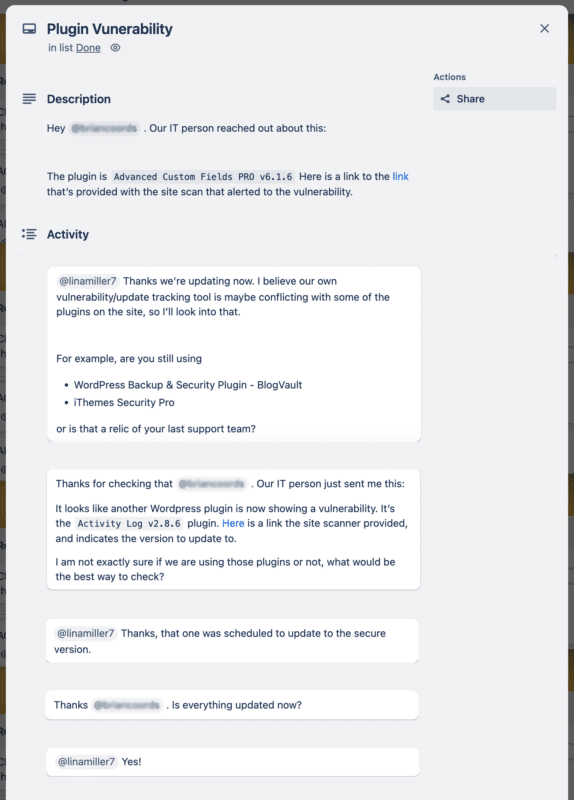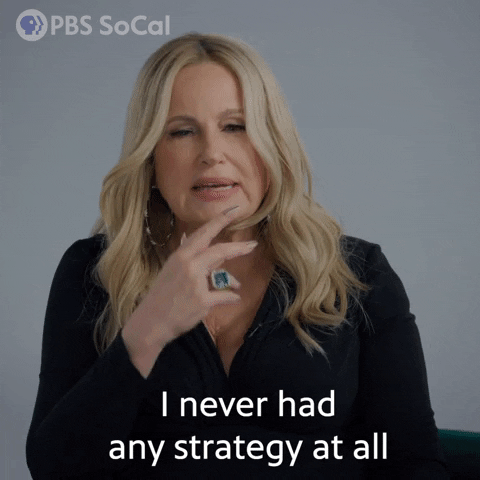As a Senior Marketing Specialist, I regularly work with vendors — from SEO experts to website developers to photographers. Throughout the years, I’ve had my fair share of stressful, disappointing vendor experiences. Luckily, I’ve also had some stand-out relationships with vendors. Here are a few tips and tools that made the difference.
1. Have regularly scheduled check-ins.

Ugh, another meeting?! While everyone strives for a clear calendar, these meetings are not worth missing. The cadence, length, and format of your syncs will change depending on the nature of the work the vendor is doing for you.
Currently, my team has a weekly meeting with our SEO vendor. This is essential for my team, as our vendor and I work through heavy SEO to-do lists weekly. Our weekly syncs allow us to review work done in the prior week, talk about goals for the coming weeks, and set a plan for the next week. If you have a less intense vendor relationship, try a monthly meeting. Even 30 minutes a month can be the difference between a buttoned-up strategy and a jumble of directionless to-dos.
The structure of these meetings will vary, but you and your vendor must come prepared with updates and questions to make the most of your time together. Some teams may use agendas while others may use slide decks. Talk to your vendor to try to align on a structure that works for you!
Not only do these meetings get everyone on the same page, but it gives ample time to get to know your vendor in a more casual way than an email can offer. Casual, social relationships help build respect and trust, essential building blocks of successful professional relationships.
Do ✅: Find (and stick to!) a meeting cadence that works for your team and your goals.
Don’t 🚫: Communicate exclusively through email.
2. Use task management software.

Everyone who knows me knows that I am an Asana stan (Asana, I 💘 you). Everyone on my team is a generalist. This often means we bop from task to task, tacking website redesigns, printed sales assets, social media posts, and demand generation strategies. Rather than sticky noting my desk to death, I prefer task management software. This software helps me ensure that all of my tasks are written down and have a clear due date.
My love of task tracking extends to my vendor relationships. Sharing access to task management software/documents ensures that your team and your vendor understand what needs to be done, who is responsible for completing the task, and when the task needs to be done.
In the past, my team worked with vendors who only used email to communicate about tasks and/or issues. As the one managing the vendor relationship, I often had to report updates about important tasks to our Director of Marketing. Instead of being able to pop open a clean, easy-to-read Trello board, I had to sort through email chains (often 40+ emails long) trying to determine the status of each task.
Another benefit of using traditional task-tracking software is that it allows in-app communication. Here is an example of a conversation I recently had with our website vendor:

In the above example, I could share my issue, receive feedback and questions from our vendor, and resolve the issue quickly. In former vendor relationships, this interaction could have taken more than two weeks and 10+ emails to resolve.
Do ✅: Utilize a shared Google spreadsheet or task management software for ALL of your vendor-related tasks.
Don’t 🚫: Send emails back and forth, creating confusing/hard-to-track email chains.
3. Start with strategy.

Ahh, strategy. It’s often referenced in business meetings but, in the day-to-day, hard to keep an eye on. It can be easy to default to task-driven work, especially if you have a vendor that isn’t thinking strategically. You must lead, when appropriate, your vendor meetings and relationships with strategy. Here is an example of how to reframe your to-do list and defeat the task-driven mindset.
Website SEO
- Task: Update keywords in 10 blog posts every week, ad infinitum.
- Strategy: We want to increase traffic from our blog to our contact page. To do that, we will identify blog posts relevant to our client audience. We will then research and implement keywords to increase blog traffic. We will then research and implement improvements to our CTA, driving client traffic from the strategic blog posts to our contact page.
In the above example, you can see that the task has no intended purpose or outcome. It can be easy to jump from week to week, completing tasks, without having any real purpose for your work. As such, it is imperative that you have a vendor that prioritizes overarching strategy and business goals, not just completing aimless tasks. Not sure how to determine if your vendor is thinking about strategy? Ask them! During one of your regularly scheduled meetings (see #1!), ask the vendor how they see your tasks aligning with your strategy.
We recently implemented a strategy-forward approach with one of our vendors. During our weekly sync, each slide in our slide deck outlines completed or upcoming tasks. Instead of letting those tasks stand alone, our vendor now highlights which part of our strategy is tied to each task. This helps us stay organized and also allows our team to communicate our work up the chain much more smoothly.
Do ✅: Start with strategy!
Don’t 🚫: Get lost in a sea of random to-dos.
How does your team manage vendor relationships? Let me know in the comments!

